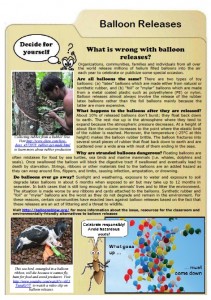Damage done by Balloon Releases…
What is wrong with balloon releases?
Organizations, communities, families and individuals from all over the world release millions of helium filled balloons into the air each year to celebrate or publicize some special occasion.
Are all balloons the same? There are two types of toy balloons: (a) “latex” balloons which are made either from natural or synthetic rubber, and (b) “foil” or “mylar” balloons which are made from a metal coated plastic such as polyethylene (PE) or nylon.
Balloon releases almost always involve the release of the rubber latex balloons rather than the foil balloons mainly because the latter are more expensive.
What happens to the balloons after they are released?
About 10% of released balloons don’t burst; they float back down to earth. The rest rise up in the atmosphere where they tend to expand because the atmospheric pressure decreases. At a height of about 8km the volume increases to the point where the elastic limit of the rubber is reached. Moreover, the temperature (-25°C at this height) makes the balloon rubber brittle. The balloon fractures into several small pieces of rubber that float back down to earth and are scattered over a wide area with most of them ending in the seas.




